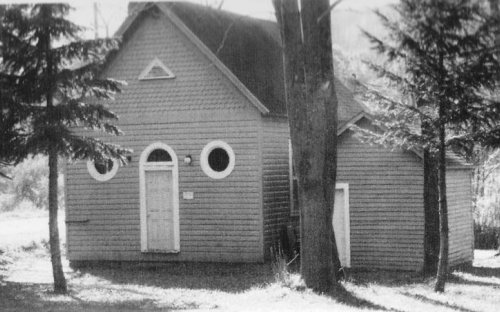The school, built in the 1870s or '80s, was in operation until 1938, when all of the one-room schoolhouses were merged into Hinsdale Central School District. Call ahead for an appointment to have this now museum opened up for you to look inside.
Ischua Schoolhouse Number 3 now stands as a testament of a by-gone era, a museum for era memorabilia. The school, built in the 1870s or '80s, was in operation until 1938, when all of the one-room schoolhouses were merged into Hinsdale Central School District, according to Rose De Cordova, curator of the museum.
The property was bought shortly after the closure by a local family for farming, but the schoolhouse remained. Ms. De Cordova said when the property was sold to a group of investors, it was one of those little inadvertent benefits in history.
"They (the investors) wanted to develop this, and (an adjoining lot)," she said. "They were going to build A-frames and sell them."
One of the A-frames still stands next to the school as a testament to the plan.
"They used the school as an office, so when I came in for the first time, there were all of these desks and chairs, and office equipment from the 1970s in here," she said. "But the floor was rotted right out. If it wasn't for the stuff that they had in here, the building probably wouldn't be standing."
The old schoolhouse boasts a feature that is rare among buildings of its type, Ms. De Cordova said.
"This was called the 'Cat's Eye School'," she said. "The two front windows are very rare, but make it look like a cat, somewhat."
Renovations in the 1970s compromised the historical integrity to the point of true loss, she said.
"We are not taking anything out," she said, "because we don't know what was here."
One of the historian's best friends in a situation like this is first-person accounts. But there is a problem with that as well.
"I cannot find anyone that went to school here," Ms. De Cordova said. "I do know that there is one woman who went here, but she is very elderly and I haven't spoken with her."
Because of the loss of first-hand accounts, very little has been able to be pieced together.
"The first school was a pole barn across the street," Ms. De Cordova said. "They moved it over here and later built the schoolhouse."
The interior of the building has become home to an extensive collection of family heirlooms, Ms. De Cordova said.
"The museum has become the home to artifacts from many area schools," she said.
Desks that were in Schoolhouse 11 have found a home. The exact location of that schoolhouse is unknown, but it is believed that Ischua did not have that many, so the seats are unlikely to have come from there. A large desk at the head of the class belonged to Ms. De Cordova's father, a longtime principal in the Ellicottville school system. Many of the items are family heirlooms.
"My mother passed away about the time I acquired the property," she said, explaining that as she was cleaning out belongings, she decided to move a lot of them into the museum.
"My (siblings) are happy that they are being kept in a collection," she said.
An old pedal organ that used to belong to her great-great-great-grandmother carries a story of its own in the school house.
"The organ made the move across the Mississippi River with great-great-great-grandmother," she said. "When her husband died, she packed up the organ and moved back."
Education is also joined by a piece of religious history in the museum as a pew from the Ischua Union Church is on display. The importance of agriculture in America in the early part of the 20th century is on display as well; several farm implements have found refuge in the building.
"The tools were my dad's," Ms. De Cordova said.
For those looking for a true treat, the far corner of the property is home to one of the supporting facilities of the Genesee Valley Canal System. The dam rests in ruin after years of neglect. The 25-foot walls still stand perfectly straight, and are in better condition than those in Hinsdale.
"The dam was part of a series that regulated spare water to flow into the Genesee Valley Canal System," Ms. De Cordova said. "The project was supposed to create a reservoir right where the town of Ischua currently is located," Ms. De Cordova said.
The plan for the dam system was drawn up in the 1850s, only to be abandoned right around the time the town of Rice, the original name for Ischua, was established.
The museum is open by appointment at this time, Ms. De Cordova said. For more information, or to set an appointment to see the property, contact Rose De Cordova at (716) 557-8809.
- Olean Times Herald, reporter Chris Chapman

